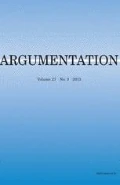Abstract
This paper explores The New Rhetoric’s concept of universal audience in the contexts of philosophical and traditional rhetorical discourse. It argues that, since Perelman’s final English-language article, published in 1984 to clarify misunderstandings among rhetorical scholars about his theory, rhetorical scholars have persisted in three primary misconceptions of the concept of universal audience: (1) appeals to the real are made only to universal audiences, (2) only universal audiences are qualified to establish the reasonableness of arguments, and (3) only universal audiences prevent The New Rhetoric’s rhetorical theory from degenerating into relativism. It explains why each of these misconceptions is inaccurate and provides a corrected view of universal audience that places it exclusively in the province of philosophical discourse. Finally, it questions whether constructed audiences in general add explanatory power to rhetorical analyses or are merely unnecessary constructs that should be dispensed with for the sake of theoretical parsimony.
Similar content being viewed by others
Notes
Hence the use of only the indefinite article and plural form for UAs throughout this paper (at least when not quoting others).
Of course, according to Perelman and Olbrechts-Tyteca, philosophers’ arguments are riddled with era- and culture-specific appeals that they do not perceive to be such.
Given the statement in The New Rhetoric that “it nonetheless remains true that, for each speaker at each moment, there exists an audience transcending all others, which cannot easily be forced within the bounds of a particular audience” (1969, 30), it is easy to see how Crosswhite may have come to believe that every rhetor appeals to a UA. However, not even in the larger context of that passage from The New Rhetoric is it clear that Perelman and Olbrechts-Tyteca are referring to a UA. In fact, UAs are specifically discussed, by name, both before and after the quoted passage, and concretely described. That the authors use such vague language to describe this “transcendent” audience that exists for every speaker when they could have simply referred again to a UA implies, to me, that they are not in fact referring to UAs at all, but to some vague entity which we all sense to exist, but which they themselves could not articulate.
Perhaps it is this hazy sense of the “transcendent universal” present in every rhetorical situation that Gross and Crosswhite are referring to in their references to “universal audience”? That may explain some of the confusion discussed. If that is the case, then it is important to remember that, in Perelman’s (1984) article, he makes abundantly clear that it was not his opinion that all arguments appeal to a UA. It would therefore help to avoid confusion if authors would be cautious not to refer to this vague “transcendent universality”—whatever we understand it to be—as a “universal audience.”
Arguably, since PAs are merely mental constructions and so cannot “listen” at all, only RAs determine the strength of arguments. Later on, it shall become clear that this is in fact my own view.
Note McClintock’s delimitation here: “…in philosophical and other scholarly argumentation.” This is a much narrower use of UA than most scholars discuss and, as has been shown, much closer to Perelman and Olbrechts-Tyteca’s own.
References
Aikin, Scott F. 2008. Perelmanian universal audience and the epistemic aspirations of audience. Philosophy and Rhetoric 41(3): 238–259.
Crosswhite, James. 1989. Universality in rhetoric: Perelman’s universal audience. Philosophy and Rhetoric 22(3): 157–173.
Crosswhite, James. 1995. Is there an audience for this argument? Fallacies, theories, and relativisms. Philosophy and Rhetoric 28(2): 134–145.
Crosswhite, James. 2010. Universalities. Philosophy and Rhetoric 43(4): 430–448.
Frogel, Shai. 2009. Who is the addressee of philosophical argumentation? Argumentation 23(3): 397–408.
Gross, Alan. 1999. A theory of the rhetorical audience: Reflections on Chaim Perelman. Quarterly Journal of Speech 85(2): 203–211.
Johnstone Jr, Henry W. 1978. Validity and rhetoric in philosophical argument. University Park: Dialogue Press of Man and World.
Jørgensen, Charlotte. 2009. Interpreting Perelman’s universal audience: Gross versus Crosswhite. Argumentation 23(1): 11–19.
McClintock, Sara L. 2008. Rhetoric and the reception theory of rationality in the work of two Buddhist philosophers. Argumentation 22(1): 27–41.
Perelman, Chaïm. 1982. The realm of rhetoric. Notre Dame, IN: University of Notre Dame Press.
Perelman, Chaïm. 1984. The new rhetoric and the rhetoricians: Remembrances and comments. Quarterly Journal of Speech 70(2): 188–196.
Perelman, Chaïm. 2007. The new rhetoric: A theory of practical reasoning. In The rhetoric of Western thought (9th ed.), eds. James L. Golden, Goodwin F. Berquist, William E. Coleman, and J. Michael Sproule, 326–345. Dubuque, IA: Kendall/Hunt Publishing Company.
Perelman, Chaïm, and Lucie Olbrechts-Tyteca. 1969. The new rhetoric: A treatise on argumentation. Notre Dame, IN: University of Notre Dame Press.
Ray, John W. 1978. Perelman’s universal audience. Quarterly Journal of Speech 64(4): 361–375.
Tindale, Christopher W. 2006. Constrained maneuvering: Rhetoric as a rational enterprise. Argumentation 20(4): 447–466.
Tindale, Christopher W. 2010. Ways of being reasonable: Perelman and the philosophers. Philosophy and Rhetoric 43(4): 337–361.
Tindale, Christopher W. 2013. Rhetorical argumentation and the nature of audience: Toward an understanding of audience—Issues in argumentation. Philosophy and Rhetoric 46(4): 508–532.
Toulmin, Stephen E. 1958. The uses of argument. London: Cambridge University Press.
van Eemeren, Frans H., and Rob Grootendorst. 1995. Perelman and the fallacies. Philosophy and Rhetoric 28(2): 122–133.
Author information
Authors and Affiliations
Corresponding author
Rights and permissions
About this article
Cite this article
Sigler, J.E. The New Rhetoric’s Concept of Universal Audience, Misconceived. Argumentation 29, 325–349 (2015). https://doi.org/10.1007/s10503-015-9349-3
Published:
Issue Date:
DOI: https://doi.org/10.1007/s10503-015-9349-3



